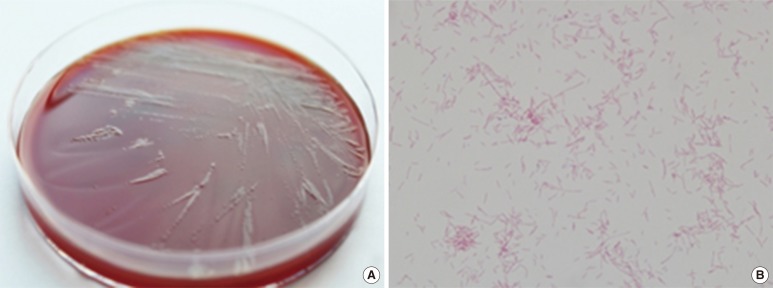Ann Lab Med.
2014 Jul;34(4):325-327. 10.3343/alm.2014.34.4.325.
Capnocytophaga sputigena Bacteremia in a Patient with Chronic Lymphocytic Leukemia
- Affiliations
-
- 1Department of Laboratory Medicine, Seoul National University College of Medicine, Seoul, Korea. trust99@snu.ac.kr
- 2Department of Laboratory Medicine and Research Institute of Bacterial Resistance, Severance Hospital, Yonsei University College of Medicine, Seoul, Korea.
- KMID: 1791943
- DOI: http://doi.org/10.3343/alm.2014.34.4.325
Abstract
- No abstract available.
MeSH Terms
-
Adult
Anti-Bacterial Agents/pharmacology/therapeutic use
Bone Marrow Transplantation
Capnocytophaga/drug effects/genetics/*isolation & purification
Gram-Negative Bacterial Infections/complications/*diagnosis/drug therapy
Humans
Leukemia, Lymphocytic, Chronic, B-Cell/complications/*diagnosis
Male
Microbial Sensitivity Tests
Penicillanic Acid/analogs & derivatives/pharmacology/therapeutic use
Piperacillin/pharmacology/therapeutic use
RNA, Ribosomal, 16S/chemistry/metabolism
Sequence Analysis, RNA
Sequence Homology, Nucleic Acid
Transplantation, Homologous
Treatment Outcome
Anti-Bacterial Agents
Penicillanic Acid
Piperacillin
RNA, Ribosomal, 16S
Figure
Reference
-
1. Ooshima T, Nishiyama N, Hou B, Tamura K, Amano A, Kusumoto A, et al. Occurrence of periodontal bacteria in healthy children: a 2-year longitudinal study. Community Dent Oral Epidemiol. 2003; 31:417–425. PMID: 14986909.
Article2. Bonatti H, Rossboth DW, Nachbaur D, Fille M, Aspock C, Hend I, et al. A series of infections due to Capnocytophaga spp. in immunosuppressed and immunocompetent patients. Clin Microbiol Infect. 2003; 9:380–387. PMID: 12848750.3. Jolivet-Gougeon A, Sixou JL, Tamanai-Shacoori Z, Bonnaure-Mallet M. Antimicrobial treatment of Capnocytophaga infections. Int J Antimicrob Agents. 2007; 29:367–373. PMID: 17250994.4. Zbinden R, von Graevenitz A. Actinobacillus, Capnocytophaga, Eikenella, Kingella, Pasteurella, and other fastidious or rarely encountered gram-negative rods. In : Versalovic J, Carroll KC, Funke G, Jorgensen JH, Landry ML, Warnock DW, editors. Manual of clinical microbiology. 10th ed. Washington, DC: ASM Press;2011. p. 574–587. in press.5. Imamura T, Miura T, Nakamura I, Kunihiro M. A case of septicemia due to Capnocytophaga sputigena. Kansenshogaku Zasshi. 1987; 61:713–718. PMID: 3119744.6. Douvier S, Neuwirth C, Filipuzzi L, Kisterman JP. Chorioamnionitis with intact membranes caused by Capnocytophaga sputigena. Eur J Obstet Gynecol Reprod Biol. 1999; 83:109–112. PMID: 10221619.7. García-Cía JI, Esteban J, Santos-O'Connor F, Román A, Soriano F. Mixed bacteremia with Capnocytophaga sputigena and Escherichia coli following bone marrow transplantation: case report and review. Eur J Clin Microbiol Infect Dis. 2004; 23:139–141. PMID: 14712364.8. Funada H, Machi T, Yoneyama H, Matsuda T, Miura H, Ezaki T, et al. Capnocytophaga sputigena bacteremia associated with acute leukemia. Kansenshogaku Zasshi. 1993; 67:622–628. PMID: 8360517.9. Torrús D, González JA, Boix V, Portilla J. Aortic endocarditis due to Capnocytophaga sputigena . Med Clin (Barc). 1995; 105:119. PMID: 7603114.10. Alanen A, Laurikainen E. Second-trimester abortion caused by Capnocytophaga sputigena: case report. Am J Perinatol. 1999; 16:181–183. PMID: 10458530.11. Vandemeulebrouck B, Rasigade JP, Sobas C, Vialet A, Roubille M. Septicaemia with Capnocytophaga sputigena in a newborn child. Ann Biol Clin (Paris). 2008; 66:215–219. PMID: 18390433.12. Atmani S, Wanin S, Bellon G, Reix P. Capnocytophaga sputigena pleuropneumonitis: a case report. Arch Pediatr. 2008; 15:1535–1537. PMID: 18804973.13. Chan JF, Wong SS, Leung SS, Li IW, To KK, Cheng VC, et al. Capnocytophaga sputigena primary iliopsoas abscess. J Med Microbiol. 2010; 59:1368–1370. PMID: 20634330.14. Li A, Tambyah P, Chan D, Leong KK. Capnocytophaga sputigena empyema. J Clin Microbiol. 2013; 51:2772–2774. PMID: 23698526.15. García Lozano T, Lorente Alegre P, Linares Latorre MD, Aznar Oroval E. Fatal bacteremia related to Capnocytophaga sputigena in a hematological patient with type T non-Hodgkin lymphoma. Diagnosis by 16S rRNA gene sequencing. Rev Argent Microbiol. 2012; 44:170–172. PMID: 23102464.16. Clinical and Laboratory Standards Institute. Methods for antimicrobial dilution and disk susceptibility testing of infrequently isolated or fastidious bacteria. M45-A2. Wayne, PA: Clinical and Laboratory Standards Institute;2010.17. Roh KH, Yong D, Cho DH, Woo K, Lee K, Chong Y. Three cases of bacteremia by Capnocytophaga spp. Korean J Clin Pathol. 2001; 21:490–494.18. Fedorko DP, Drake SK, Stock F, Murray PR. Identification of clinical isolates of anaerobic bacteria using matrix-assisted laser desorption ionization-time of flight mass spectrometry. Eur J Clin Microbiol Infect Dis. 2012; 31:2257–2262. PMID: 22371295.
Article19. Gomez-Garces JL, Alos JI, Sanchez J, Cogollos R. Bacteremia by multidrug-resistant Capnocytophaga sputigena. J Clin Microbiol. 1994; 32:1067–1069. PMID: 8027314.20. Wang HK, Chen YC, Teng LJ, Hung CC, Chen ML, Du SH, et al. Brain abscess associated with multidrug-resistant Capnocytophaga ochracea infection. J Clin Microbiol. 2007; 45:645–647. PMID: 17135428.
- Full Text Links
- Actions
-
Cited
- CITED
-
- Close
- Share
- Similar articles
-
- Three Cases of Bacteremia by Capnocytophaga spp.
- First Case of Transformation of Immunoglobulin Heavy Chain Variable-Mutated Chronic Lymphocytic Leukemia Into Chronic Myeloid Leukemia
- A Case of Leukemia Cutis Associated with B-cell Chronic Lymphocytic Leukemia
- Leukemic Macrocheilitis Associated with Chronic Lymphocytic Leukemia
- A case of B cell chronic lymphocytic leukemia involving thyroidgland


